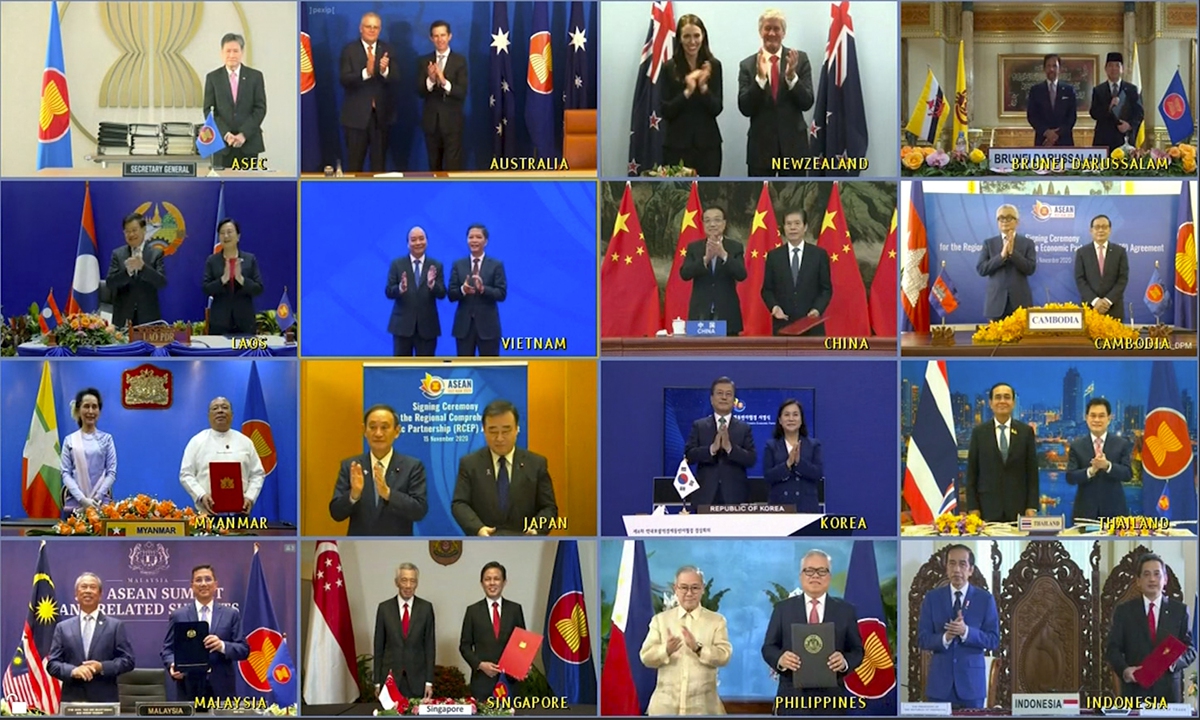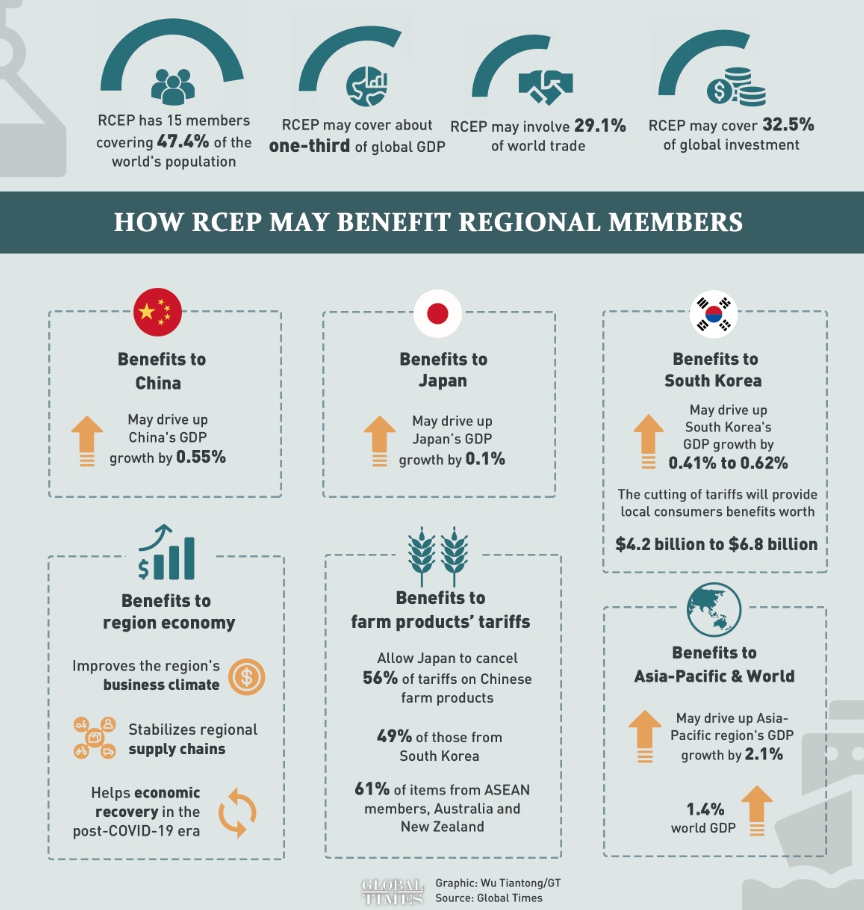China, 14 other economies sign RCEP in historic win for multilateralism
By Xie Jun and Chi Jingyi Source: Global Times Published: 2020/11/15 12:53:20

This image made from a teleconference provided by the Vietnam News Agency (VNA) shows the leaders and trade ministers of 15 Regional Comprehensive Economic Partnership (RCEP) countries pose for a virtual group photo in Hanoi, Vietnam on Sunday. Photo: AP
China and 14 other economies signed the world's largest trade deal, the Regional Comprehensive Economic Partnership (RCEP), on Sunday to form a free trade zone in the Asia-Pacific region that will encompass a third of the global economy, in what Chinese officials and experts call a historic win for multilateralism that would help the regional and global economies cope with the COVID-19 pandemic and rising protectionism.
Inked after years of negotiations and coming at a critical turning point in the global political climate - when the next US administration is set to take office and the world is grasping for solutions to tackle challenges arising from the coronavirus pandemic, the new regional deal would also help the Asia Pacific region take lead in recovering from the COVID-19 pandemic and resist US hegemony in the region, economists said.
On Sunday, Chinese Premier Li Keqiang spoke highly of the pact, saying it is not only an achievement of landmark significance in East Asian regional cooperation, but also a victory of multilateralism and free trade.
"Signed after eight years of negotiation, the RCEP lets people see brightness and hope in shadows, proving that multilateralism and free trade remain the main and correct course as well as the right direction for the global economy and mankind," Li said.
The deal, which encompasses China, Japan, South Korea, Australia, New Zealand and the 10 members of the Association of Southeast Asian Nations, will create what is to be the world's largest free trade zone, covering about one-third of the world's total population and GDP. It will also be Japan's first free trade framework with its vital trading partners China and South Korea.
Notably, two major economies - the US and India - are left out of the trade pact. The US, under President Donald Trump, has been pushing for bilateral deals rather than multilateral ones. India was part of the negotiations, but pulled out of the negotiation last year.
Chinese economists also applauded the signing of the pact, saying that the pact mirrors China's leading role in pushing multilateral cooperation, which is in sharp contrast to the US government's acts aimed at an economic decoupling not only between the US and China, but among major global economies as well.
"The signing of the RCEP shows China, which played a very active role in pushing for the deal, has led the way in liberalizing trade and promoting a global market order based on free competition. It shows China provides the world with a Chinese model and a Chinese solution on the open platform, where it serves the world," Bao Jianyun, professor of the School of International Studies and director of the Center for International Political Economy Studies at the Renmin University of China, told the Global Times.
Liu Kuikui, a Beijing-based consultant on international transport and trade, told the Global Times that the participation of some US allies like Japan and Australia in the RCEP also showed that the US' protectionism and economic hegemony is increasingly losing supporters even among the country's usual "friends".
"It signals that the US is becoming increasingly marginalized in Asia, and that it has actually lost discourse power on Asian economic issues," Liu commented.
Chen Fengying, a research fellow at the China Institutes of Contemporary International Relations, also noted that the signing of the deal is a correction of the protectionist course of the past several years, when the China-US trade war raised questions about global cooperation. "But the RCEP's signing is a signal that cooperation does work, which I think is even more important than the lift it gives to specific countries' GDP growth," Chen told the Global Times.

Infographic: GT
A lot to expect
The megadeal's successful signing has also raised hopes for economic turnaround in the Asia-Pacific region in the post-coronavirus era, as it is expected to boost regional trade volume and strengthen other forms of economic exchange.
Comprised of 20 chapters covering areas from commodity trade to services trade, e-commerce and government procurement, the pact would likely deliver major results in a short period of time. Under the deal, members will aim to reduce tariffs to zero in 10 years; in some cases, tariffs might be scrapped immediately, China's Ministry of Finance (MOF) said on Sunday. In particular, it is also the first time that China and Japan arranged to decrease tariffs for each other.
Chen Bo, director of the Digital Finance Research Center at the Central University of Finance and Economics, predicted that with the support of the RCEP, negotiations on China-Japan-South Korea free trade zone might also speed up.
"I think China, Japan and South Korea might scrap tariffs for each other on certain products shortly, but general tariff removal would require further step-by-step negotiations, given the complicated relations among the three countries," he told the Global Times.
Experts also have high hopes about the Asian countries getting back on the horse economically after the pandemic, stimulated by the pact. For example, Chen predicted that the RCEP would reduce about $150-200 billion worth of losses for China, Japan and South Korea caused by the China-US trade war. He also noted that the RCEP's signing would speed up integration and improvement of Asia-Pacific supply chains, giving birth to the world's largest market and largest supply chains.
Previous estimates also showed that removal of tariff and non-tariff barriers alone under the RCEP would increase the Asia-Pacific region's GDP by 2.1 percent and world GDP by 1.4 percent.
Liu said that the signing of the RCEP will integrate its members into the largest free trade zone in the world and build Asia into a region of integrative trade similar to other global trading blocs such as the EU and the North American free trade area.
Pressure for US, room for India
Experts further stressed that the signing of the RCEP would add pressure on the US government, as the next US administration will face a novel global trade paradigm characterized by a major regional free trade system not led by Western countries, but with China as the major promoter and contributor.
And although this does not mean the US has completely failed in its attempt to contain China, or it would stop efforts to undermine China's rise in the Asia-Pacific region, it has largely increased the costs and uncertainties for US strategies against China in this area, they said.
"The forming of the RCEP would deal a heavy blow to the US Indo-Pacific strategy, particularly in the trade sector, as it largely hits the US' ability to influence and interfere with Asia-Pacific issues. This would be a pressure whether Trump or Biden is in office," Bao said. He predicted that the next US administration might join the Trans-Pacific Partnership (TPP) Agreement again to adopt an aggressive stance on the RCEP.
Liu also predicted that Biden would be pushed to reconsider US economic hegemonism and protectionism, and would need to rebuild US' economic relations with other countries in order to comply with the trend of economic globalization, if he assumes office as the new US president.
"Biden won't copy Trump's policies, and China-US trade war should ease in a certain period. The RCEP, in my view, would affect the pace and degree of such a thaw," Bao said.
Besides, the RCEP didn't rule out India's participation, although the country has not returned to the negotiation table after it bowed out in 2019, despite Japan's efforts to draw it back.
Hu Qimu, a senior fellow at the Sinosteel Economic Research Institute, predicted that India wouldn't join the RCEP in the short term, as the pact's commodity trade terms are not very attractive to a country reliant upon software outsourcing industries like India, and that India is more inclined to side with the US on frictions with China.
However, the RCEP has not entirely shut the door on India, but left room for future changes. "I think that has set an example of an open, step-by-step, sustainable model of regional talks that can be generalized in other, like WTO, talks as well," Chen noted.